
THIS year's government work report stated that China will continue to facilitate ecological advancement, maintain the balance between development and environmental protection, and boost sustainable development, adding that this year China will continue to roll out major engineering projects to protect and restore ecosystems.
今年的政府工作报告指出,应坚持绿水青山就是金山银山的理念,健全生态文明制度体系,处理好发展和保护的关系,不断提升可持续发展能力。今年,我国将持续实施重要生态系统保护和修复重大工程。
Matteo Convertino from Italy is an associate professor at the Institute of Environment & Ecology of Tsinghua Shenzhen International Graduate School and the principal investigator (PI) of the school’s Future Ecosystem Lab (TREES) that is focused on ecosystem risk assessment, sensing and forecasting, management and engineering. In his opinion, nature should be rebuilt as a new infrastructure by leveraging hydroclimatic risks.
意大利生态工程师马泰奥·孔韦尔蒂诺(Matteo Convertino)认为,生态修复应当成为一种新基建,以应对水文气候风险。孔韦尔蒂诺目前担任清华大学深圳国际研究生院环境与生态研究院副教授、该校的未来生态系统实验室(Future Ecosystem Lab)首席研究员,该实验室专注于生态系统风险评估、监测、预估、管理及工程实施。
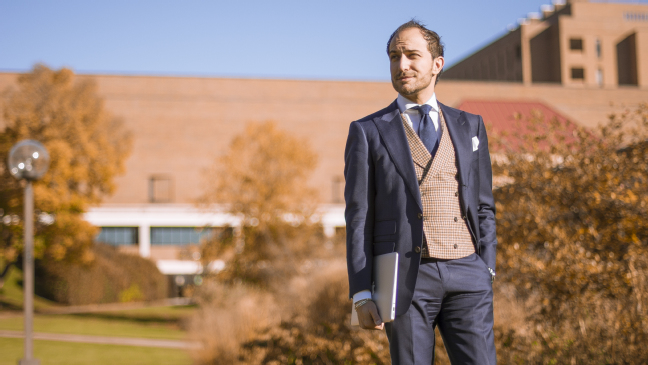
Matteo Convertino 马泰奥·孔韦尔蒂诺
“Restoration is not just an ecological problem, but also a social problem,” said Convertino during an interview with Shenzhen Daily. “In addition to bringing back ecosystems as they were, we should also consider the needs of the present and future generations within a nature-based development.”
在接受英文《深圳日报》专访中,孔韦尔蒂诺表示:“生态系统修复不只是生态问题,同时也是社会问题。在恢复原生态系统的基础上,我们应该考虑如何通过修复自然来满足人类当下以及未来的需求。”
To further explain, the professor cited the efforts of expanding mangrove forests to cope with rising sea level as an example. “The mangrove forests should be expanded not only because they were larger in the past, but also because in the future we may face more problems from the rising sea level as well as other unexpected risks, which will affect our city,” he said.
通过红树林人工造林来应对海平面上升就是一个很好的例子。孔韦尔蒂诺说道:“种植红树林,不只是因为过去的红树林面积更大。未来,城市将面临海平面上升等更多无法预料的问题,这也是进行红树林造林的原因。”
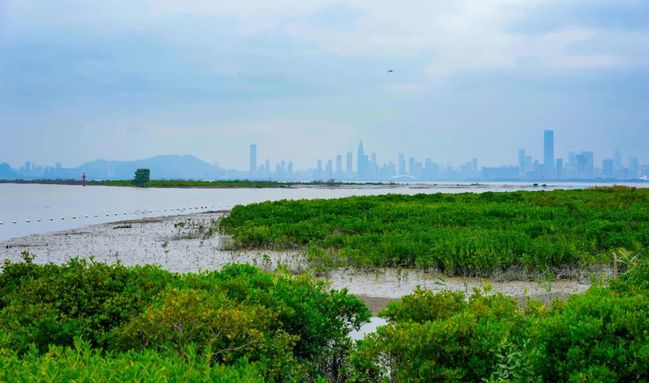
A scene of Futian Mangrove Wetland at the the IBC 2017 Memorial Garden in Futian Mangrove Ecological Park. Liu Xudong 从福田红树林生态公园南区远眺福田红树林湿地。刘旭东摄
“Mangroves can absorb a huge amount of carbon. Carbon neutrality is not only about reducing emissions from industries and vehicles, but also about improving the capacity of species that are able to 'draw down' the carbon,” he added.
孔韦尔蒂诺进一步解释道,红树林可以吸收大量的二氧化碳,而碳中和不仅需要工业、汽车减排,也需要进一步发挥自然物种的“减碳”能力。
“Sea level is both a climate and local development problem. To solve it, we improve nature because nature can be a boundary, a filter and a flexible barrier not made with concrete, but with plants and all co-dependent species,” he added.
“海平面上升既是气候问题,也是当地发展问题。要解决这个问题,就需要提升自然,因为自然能够起到围挡、过滤的作用,通过植物以及依赖于此的其他物种,我们可以建造一道没有水泥的屏障。”孔韦尔蒂诺说道。
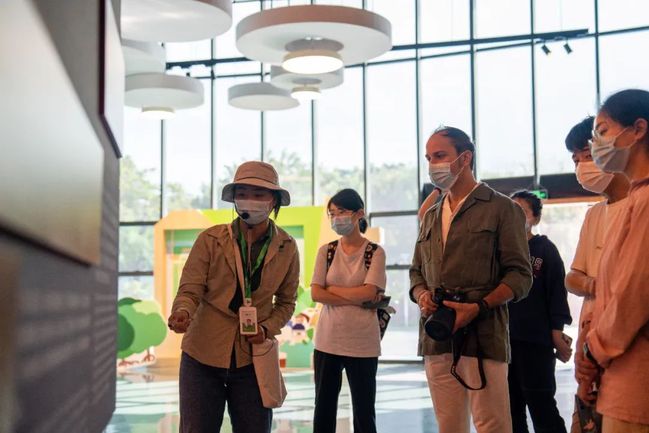
Convertino (in olive-green shirt) visits the nature education exhibition hall at Futian Mangrove Ecological Park with his students. Lin Jianping 孔韦尔蒂诺(身着橄榄色衬衫)与学生们一起参观红树林生态公园科普展厅。林建平摄
During his experience in Shenzhen, Convertino has seen several projects in the city that are aligned towards the objectives of protecting nature, improving the urban built environment and providing a leisure space for residents.
孔韦尔蒂诺认为,深圳有一批项目,既兼顾自然保护和提升城市建筑环境,同时也为市民提供了休闲空间。
“A mangrove community was restored in Dongchong at the back bay of the beach,” he said. “For the mangrove community, in addition to restoring water flow, they also made new residences, new little houses, where people can go to enjoy their vacations.”
其中一个项目就是东涌的红树林公园。“在东涌的红树林公园,人们除了修复水流,也建造了一些小屋,大家可以去那里度假,”孔韦尔蒂诺说道。
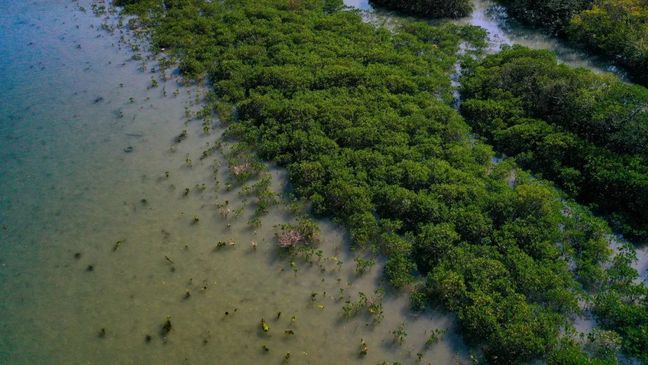
A bird's-eye view of mangrove forests in Dongchong, Dapeng New Area. Liu Xudong 俯瞰东涌红树林湿地。刘旭东摄
Shenzhen Talent Park is another good example of how nature and people can coexist. “The park is a nice space for families to enjoy their time together and is also a necessary habitat for flood protection. It was actually built as a flood protection area. If the tide gets too high, especially in summer concomitant with extreme rainfall, most of the water can be contained in the inner bay that is relatively large and deep,” the professor explained.
深圳人才公园是另一个自然和人类和谐共存的地方。孔韦尔蒂诺告诉记者,“人才公园为家庭提供了休闲空间,也起到了防洪的作用。实际上,当时建人才公园内湖,就是为了防洪。如果潮水太高,尤其是在夏天雨量增多的情况下,大部分雨水都可以被收集在较大和较深的内海湾。”
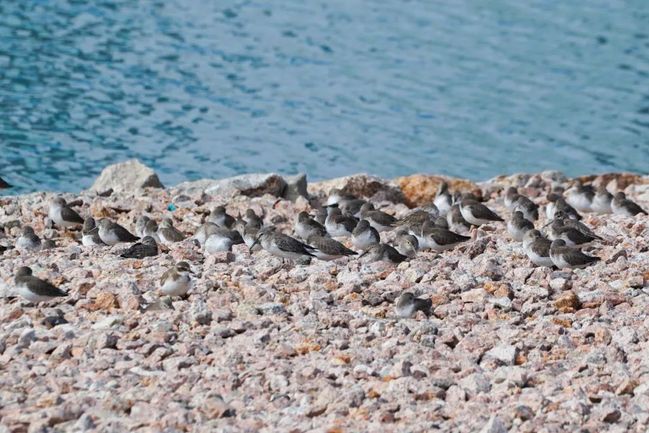
A flock of shorebirds, including Kentish plover and dunllins, take a rest on a pebble beach of Talent Park. Wang Haolan 在人才公园石滩上休息的环颈鸻、黑腹滨鹬等候鸟。王皓岚摄
Shenzhen is a city peppered with parks large and small, which provide recreation spaces for its residents. However, the engineer has noticed exotic plant species in many of the parks. “There is a big misconception among people. Many times, I walk in parks and find people believing that the parks are real nature, pristine ecosystems. But in reality, they are not. They are almost totally humanmade,” he said.
深圳是一座公园之城,这些公园为市民们提供了休闲场所。然而,孔韦尔蒂诺在很多公园都发现了外来物种。“人们对于公园有一种误解。”孔韦尔蒂诺说道。“我经常在公园里碰到很多人以为公园就是真正的大自然,以为那就是原始的生态系统。但事实并非如此,公园几乎都是人造的。”
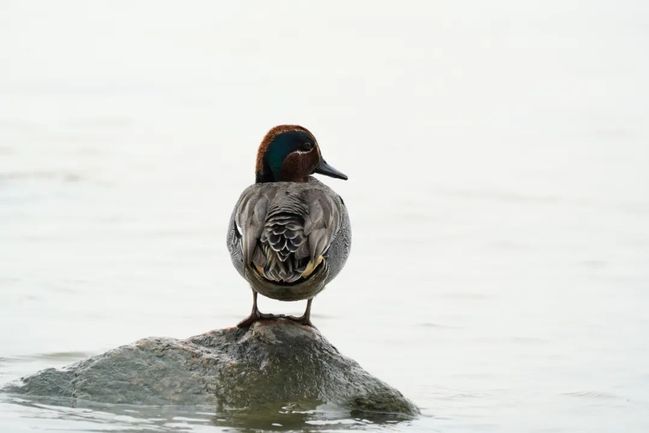
A male Eurasian teal at Shenzhen Bay Park. Wang Haolan 深圳湾公园的雄性绿翅鸭。王皓岚摄
“So we must be careful and involve scientists in the process of park construction in order to avoid introducing species that may irreversibly damage the rest of the ecosystems,” the professor said. “I hope that, for the future, universities, government and the industry will work together in deciding what to do, where to do it, and how to do it, considering both restoration and development of new ecosystems by balancing ecology and society in lights of future risks. I believe that we can engineer a much greener environment that is also good for ourselves as human beings.”
因此,孔韦尔蒂诺建议,让科学家参与修建公园的过程,避免引入可能永久性破坏原生态系统的外来物种。“我希望未来大学、政府和企业能够互相协作,共同决定生态修复的方式、地点和方式,从未来风险的角度出发,通过平衡生态和社会需求,去思考生态系统修复以及发展新的生态系统。我相信,通过生态工程,我们可以营造出更加绿色,同时也能够改善人类生活的环境。”孔韦尔蒂诺说道。
转自“Shenzhen Daily”公众号








